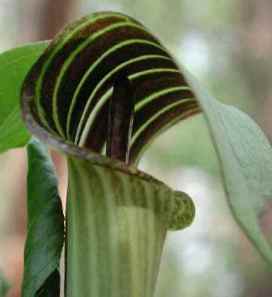Bon appétit, Jack!
Arisaema triphyllum is part of the Kingdom Plantae, which includes all plants. This means that the jack-in-the-pulpit acquires the nutrients it needs to function via a process called photosynthesis. Photosynthesis follows this basic equation:
6CO2 +6H2O = C6H12O6 + 6O2
More plainly, a plant will take in carbon
dioxide and water and convert them into
sugar after absorbing light. In this
process, it also produces oxygen as a
byproduct.
As in most plants, photosynthesis takes
place in the leaves of the
jack-in-the-pulpit. Although the
spathe, which is Jack's canopied "pulpit", is actually a modified leaf, it does
not conduct photosynthesis. In all
other leaves, the chloroplasts are the
special organelles that are involved
directly in photosynthesis. An
organism that uses photosynthesis to create
energy is very dependent on its environment.
Find out where the
jack-in-the-pulpit lives!
Of course, photosynthesis is a lot
more complicated than that. For a more
detailed explanation of this process, check
out this page devoted to
photosynthesis.
 Back on the
adaptation page, it was mentioned that
Arisaema triphyllum is a part of a
subkingdom called Tracheobionta, which means
that it is a vascular plant. Vascular
plants contain xylem and phloem, which are
known as vascular tissue. This tissue
is in charge of the transport of water,
nutrients, and sugars. Water and
nutrients are transported by the xylem from
the roots to the leaves of the plant.
Conversely, the phloem carries the sugars
produced by photosynthesis down from the
leaves to the rest of the plant.
Back on the
adaptation page, it was mentioned that
Arisaema triphyllum is a part of a
subkingdom called Tracheobionta, which means
that it is a vascular plant. Vascular
plants contain xylem and phloem, which are
known as vascular tissue. This tissue
is in charge of the transport of water,
nutrients, and sugars. Water and
nutrients are transported by the xylem from
the roots to the leaves of the plant.
Conversely, the phloem carries the sugars
produced by photosynthesis down from the
leaves to the rest of the plant.
Arisaema
triphyllum is placed in the family
Araceae because it possesses what is known
as a corm. The corm is in charge of
storage. The sugars created by
photosynthesis that aren't immediately used
to meet the plant's various needs are stored
in the corm for future use. The amount of
energy stored in the corm plays a large role
in the gender of the jack-in-the-pulpit the
following season. If the plant has a
rough year and hasn't stored much energy in
the corm, it will most likely return as a
male flower. If, on the other hand,
the plant has a good year and is able to
store up more energy, it has a greater
chance of being a female flower the next
season. Head over to the
reproduction
page to learn more about the
jack-in-the-pulpit's reproductive cycle.
